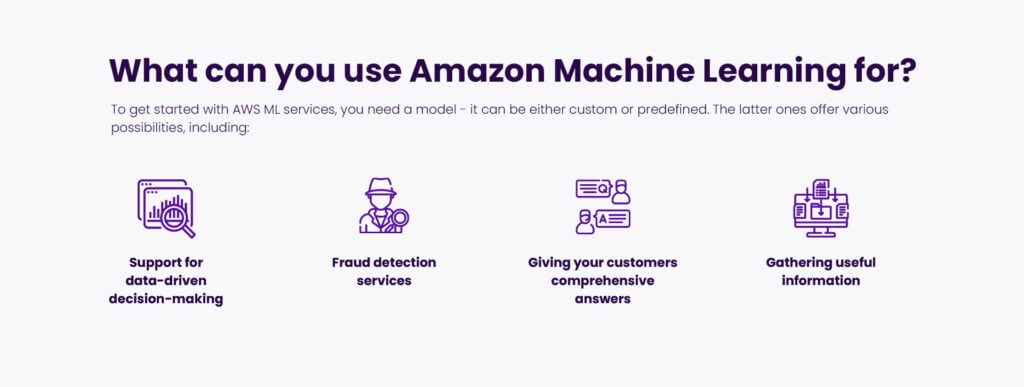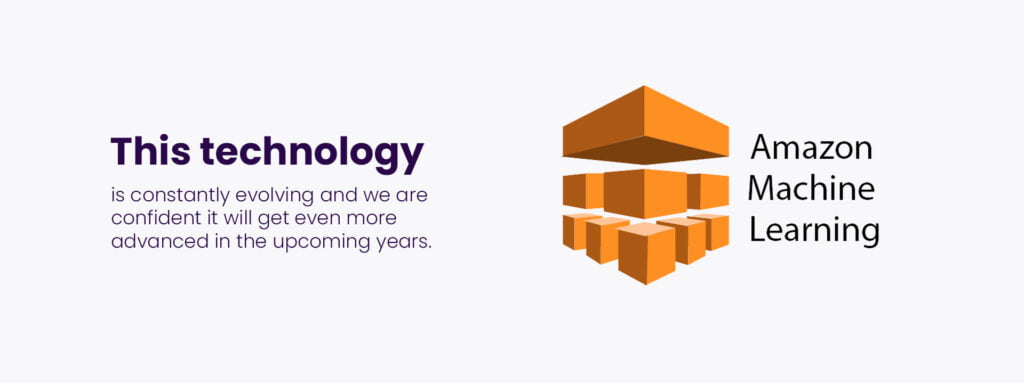What is Amazon Machine Learning?

Alexa Trachim

Machine learning is an extremely fascinating subject. Applying it to our daily lives with the help of software products became one of our goals recently. Now we are exploring all available solutions – because machine learning doesn’t necessarily have to be done from scratch. There are some tools and services that offer robust and functional ways to introduce ML to your application. One of them being Amazon Web Services (AWS).
Table of contents
1. What is machine learning?2. What is AWS?
3. What is Amazon Machine Learning?
4. What is Amazon SageMaker?
5. AWS ML services features
6. Summary
What is machine learning?
If you didn’t saw our article on machine learning yet, you should definitely catch up. It’s a short guide that explains all the basics – like the definition, types of algorithms and machine learning models – to readers interested in the subject. Here’s the essential explanation of the machine learning term:
“Machine learning (ML) is the field of science that fuses robotics, statistics and informatics. It is a part of scientific studies that deal with artificial intelligence (AI). The primary purpose of machine learning is to create an automatic system that can improve itself without human interference. The only thing it uses is collected data that is analyzed by it to find specific patterns impossible to spot by people. This way, the machine can learn new things only by analyzing existing information and drawing conclusions out of it.”
To make it even more simple, machine learning is meant to imitate the human brain and its abilities to understand particular phenomenons based on previous examples. The computer can achieve that with the help of specially developed algorithms that help it learn and improve itself.
You should also know that there are various machine learning models. Some of them need to be provided with an example of a predefined feature the algorithm should look for when analyzing the data. Others do not need it – they just browse the information and look for regularities or anomalies.
To implement machine learning in our software products, we use various established services.
What is AWS?
AWS (Amazon Web Services) is the world’s most comprehensive and broadly adopted cloud platform. From infrastructure technologies like commute storage and databases to machine learning and artificial intelligence – you can build basically everything you can imagine with AWS.
AWS offers various services that are based on its globally located data centers. Why? Because Amazon Web Services provide multiple benefits for any type of business – no matter if it’s a startup, a big corporation, or state organization. Using AWS helps to achieve lower costs of the infrastructure, introduce innovative solutions and organize work in a productive and efficient way.
Amazon Web Services include many types of digital tools – like file storage, cloud computing, databases – and more advanced solutions based on artificial intelligence like machine learning. What distinguishes AWS is its high functionality and application support, no matter its size and purpose. Amazon Web Services is suitable for almost any type of software product one would like to develop.
In this article, we focus on Amazon Machine Learning and Amazon SageMaker – AWS services dedicated to ML solutions. The main problem is that Amazon Machine Learning is no longer available to new customers. Instead, Amazon SageMaker is recommended. We will compare both these options for those who still have access to Amazon ML and users who want to use AI solutions from Amazon and wonder what SageMaker can offer that ML doesn’t. Let’s find out what their capabilities are and where they are different from each other.
What is Amazon Machine Learning?
If you want to learn how to introduce machine learning into your product – using Amazon Machine Learning by AWS is the best place to get started. It’s a complete toolkit available for free within Amazon Web Services. The main advantage of Amazon Machine Learning is that it walks the user through the whole process – from picking the right model to analyzing the data. It enables developers to implement ML into any kind of software.
Amazon Machine Learning shares tutorials and guides for every person that is interested in this part of AWS. We can find a lot of materials that are dedicated to beginners and advanced ML users.
What’s interesting about AWS’s ML services is that you don’t need a complex infrastructure to implement it into your app. Instead of coding, developers just need to install the API provided by AWS after you pick the model. And that’s it – your solution is ready to be used. You can also receive data predictions from AWS in real-time or batch them to see a bigger picture based on all the information. You can pick both if that’s what you need.

What can you use Amazon Machine Learning for?
There are many instances when using Amazon Web Services for ML might be justified. The general reason is to pay less for a high-quality solution with outstanding performance. Developing such on one’s own would take a lot of time and would require a significant budget.
To get started with AWS ML services, you need a model – it can be either custom or predefined. The latter ones offer various possibilities, including:
- Support for data-driven decision-making, where AWS presents conclusions based on data analysis to give you a clear image of your process and needed improvements.
- Fraud detection services to monitor any suspicious activities to prevent them in the future.
- Giving your customers comprehensive answers to their most common questions and complaints thanks to AWS services.
- Gathering useful information for marketing and sales by getting reports about consumer behaviors and using suggestions and predictions to deliver better creations.
What is Amazon SageMaker?
Amazon SageMaker is an AWS product that is more advanced, more progressive and predictable than Amazon Machine Learning thanks to keynotes and the algorithms that are used in this module.
Users can select their own algorithm with AWS SageMaker. Amazon Machine Learning automatically picks the algorithm for you based on the classification problem (e.g., binary, multi-class, regression) type.
Amazon SageMaker is a perfect tool for most data scientists who want to develop a truly end-to-end machine learning solution. It is a very cost-effective, fast and efficient platform. According to Amazon, “SageMaker [including Studio] is a fully managed service that removes the heavy lifting from each step of the machine learning process.”
There are a few ways to work with Amazon SageMaker. Amazon SageMaker AutoPilot provides your data in tabular form (to Amazon S3 – database) and specifies target prediction. AutoPilot is going to inspect the data and prepare it automatically. You can choose one of the built-in models, or AutoPilot will do it for you. Feature engineering, model training, tuning are all covered, but you have full visibility and control.
AWS Marketplace for Machine Learning is the easiest way to get a model. You don’t even have to train your model if you find a suitable trained solution ready to use. There are hundreds of models for NLP, computer vision, and many others, including some very advanced models. It is a good place to start PoC and learn more about the problem to decide if you need to build a new model, or you can just use an existing solution.
If you need to build your own model and get more involved in the process, you can choose one of three options:
- Use one of 17 built-in algorithms. You don’t need to write any machine learning code, just Python code to get everything going.
- Use built-in frameworks (TenorFlow, Keras, PyTorch, XGBoost, etc.) from open-source containers. You need to implement all your code in Python.
- If you are using for example C++ or Java, you need to run your own training and prediction container and then integrate with SageMaker.
Built-in algorithms available in AWS SageMaker:
- Linear Learner – regression, classification
- Factorization Machines – regression, classification, recommendation
- K-Nearest Neighbors – non-parametric regression and classification
- XGBoost – regression, classification, ranking
- K-Means – clustering
- Principal Component Analysis – dimensionality reduction
- Random Cut Forest – anomaly detection
- Object2Vec – general-purpose embedding
- Semantic Segmentation – deep learning
- Image Classification – deep learning
- Object Detection(SSD) – deep learning
- Neural Topic Model – topic modeling
- Latent Dirichlet Allocation – mostly topic modeling
- BlazingText – GPU-based Word2Vec, text classification
- Sequence-to-Sequence – machine translations, speech to text
- DeepAR – time-series forecasting – RNN
- IP Insights – usage patterns for IP addresses
When working with SageMaker studio, you don’t have to use the models provided by Amazon necessarily. You can implement local models by using containers, for example XBoost or scikit-learn.
The stages of Amazon SageMaker
AWS SageMaker is a more advanced platform in comparison to Amazon Machine Learning. You can customize all stages of machine learning algorithms development. They are called build, train and deploy.
BUILD stage
With Amazon SageMaker, it is effortless to build ML models and get them ready for training. It provides everything you need to load and clean your data. You can select and optimize the best framework and algorithm for your application.
AWS SageMaker includes many useful tools for exploring and visualizing your data, for example, Jupyter notebooks. You can store your data in Amazon S3, or you can move data from Amazon RDS, Amazon DynamoDB, and Amazon Redshift into S3 by using AWS Glue. To make your job even more fun, Amazon SageMaker includes the 17 most common machine learning algorithms that are pre-installed, optimized and ready to use. You can also run TensorFlow and Apache MXNet (the most popular open-source frameworks for developing machine learning algorithms) or your own frameworks.
TRAIN stage
After building your machine learning algorithm, you need to train it on your training dataset. For efficient training, Amazon SageMaker can tune your model automatically. It also helps you achieve the highest possible accuracy.
DEPLOY stage
Your Amazon SageMaker model is deployed on Amazon EC2 (Amazon Elastic Compute Cloud) which is an auto-scaling cluster and a web service that provides secure, scalable compute capacity in the cloud. For testing, Amazon SageMaker provides A/B testing for experimenting with different model versions that could end up with different results. This built-in option helps to determine how to achieve the best effects.
AWS ML services features
To sum it up, here are the most crucial features of both services. You can pick the one that suits your needs best. This way, you will achieve the best results with machine learning.
Amazon Machine Learning features
- Easily create machine learning models
- From models to predictions in seconds
- Scalable, high-performance prediction generation service
Amazon SageMaker features
- Build: managed notebooks for creating models, built-in high-performance algorithms, broad framework support, the ability to choose a machine learning algorithm
- Train: one-click training, automatic model tuning
- Deploy: one-click deployment, automated A/B testing, fully-managed hosting with auto-scaling
- Provides Jupyter NoteBooks running R/Python kernels with computing instance that we can choose as per our data engineering requirements on demand
- We can visualize, process, clean and transform the data into our required forms using the traditional methods (for example, Pandas, Matplotlib)

To sum it up
AWS offers two great solutions – Amazon Machine Learning and Amazon SageMaker. These ML services are genuinely seamless and accessible tools for all businesses that need to innovate their apps and want to do it using algorithms. This technology is constantly evolving and we are confident it will get even more advanced in the upcoming years. AWS might play a significant role in this expansion.
If you need to hire a software house that will create an ML solution just for you – we encourage you to contact us and let us know what you need. We work with tools from established providers like AWS and if it’s necessary – we create modified or new models of algorithms. Check out our Services page to find out that we can offer you a complex IT services package – from business consultations, through UX/UI design to web and mobile development.






